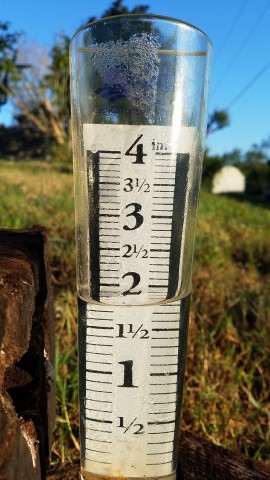
Measuring the Lifeblood of South Texas Ranches - How Many Rain Gauges Are Necessary?

November 2017
Ranches in South Texas live and die with rainfall. Knowing how much rainfall a ranch receives is critical for making management decisions because rainfall is correlated with vegetation productivity. Below average rainfall may prescribe lower cattle stocking rates and more conservative wildlife harvest rates or vice versa. Because of the large effect of rainfall in semi-arid environments such as South Texas, ranch managers often use rain gauges to measure rainfall. Some ranch managers may place a single gauge at a centralized location while others may put multiple gauges within each pasture. Does it matter how many rainfall gauges are used?
We examined patterns of rainfall measured in 14 gauges spread across a ranch near Falfurrias, Texas during years of 2013-2017. First, we examined correlation of measurements between all pairs of rain gauges during each rainfall event. Correlation ranges from 0-1 with 0 meaning there is no relationship in measurements taken at 2 rain gauges and 1 meaning there is a close relationship. So, the higher the correlation, the less value of having multiple gauges. Correlation was high, ranging from 0.78 to 0.98 which suggests measuring rainfall from multiple gauges is not worthwhile (Fig 1). However, as distance between gauges increased, correlation declined and seemed to become more variable when gauges were ≥3 miles apart. This suggests that gauges within 3 miles of each other will have similar rainfall values.

Figure 1. Correlation of measured rainfall between gauges in relation to distance (miles).
Correlation does not tell the full story. If gauge X consistently receives 1” more rainfall than gauge Y, correlation will be high. Thus, there is value in understanding absolute differences between rainfall gauges. We examined percent of gauges that differed by ¼”, ½”, ¾”, and 1” for each calendar month (Fig. 2). Over 40% of gauges within 3 miles of each other differed by ¼” most of the year (Mar-Nov). During May and September, 20% to 30% of gauges within 3 miles of each other differed by over an inch of rainfall!

Figure 2. Percent of gauges within 3 miles of each other that differed by ¼”, ½”, ¾”, and 1” during each month of the year. Example: During September, 80% of gauges had measurements that differed by a quarter inch.
The relatively high variation among gauges during the rainy season indicates most rainfall events at this time were localized (Fig. 3). During April-June and August-October, there may be value in having multiple rainfall gauges distributed across the ranch at a scale that meets ranch-specific management goals. Further, one should not assume rainfall measured from a single gauge reflects rainfall that occurred ranch-wide. During winter (Dec-Feb), gauge measurements were relatively consistent which indicates that rainfall events were usually wide-ranging, probably associated with “cold” fronts from the North. Instead of recording redundant data from multiple gauges during winter, our analysis suggests you would be justified reading a single gauge outside of your window while standing by the fireplace with a cup of hot coffee.

Figure 3. Differences in rainfall during January 2017 (consistent) and May 2015 (variable) over a 30,000 acre area. Extrapolated January rainfall ranged from 0.14-0.21” whereas May rainfall ranged from 3.5-8.0”.
So, how many rain gauges are necessary? As with many questions in wildlife and ranch management, the answer depends on your situation and goals. If a general sense of moisture conditions is sufficient for the intensity of management on your ranch, then a rain gauge for every 10,000 acres will suffice. However, if management decisions are made at a smaller scale or you have interest in understanding differences in productivity across your ranch, then a higher density of rain gauges, perhaps one for every 2,000 acres may have value. A large number of gauges takes more time to check but that time can be minimized if rain gauges are placed in areas frequented by ranch personnel and adjacent to roads that are accessible even after a heavy rain. A large number of rain gauges is not justified if ranch personnel are not dedicated to checking them regularly and entering the data. The key will be to balance your ranch’s need for rainfall data with the resources available to collect and analyze it.
Acknowledgements: We would like to thank Laborcitas Creek Ranch for providing rainfall data for this e-News.